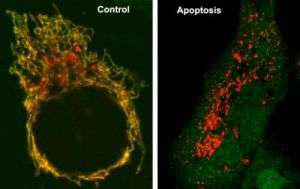Bak protein sets stressed cells on suicide path, researchers show

When a cell is seriously stressed, say by a heart attack, stroke or cancer, a protein called Bak just may set it up for suicide, researchers have found.
In a deadly double whammy, Bak helps chop the finger-like filament shape of the cell’s powerhouse, or mitochondrion, into vulnerable little spheres. Another protein Bax then pokes countless holes in those spheres, spilling their pro-death contents into the cell.
“We found out Bak has a distinct function in regulation of the mitochondrial morphology,” says Dr. Zheng Dong, cell biologist at the Medical College of Georgia and the Veterans Affairs Medical Center in Augusta and corresponding author on a paper published this week in Proceedings of the National Academy of Sciences. “Bax, on the other hand, is not involved in morphological regulation but needs to be there to puncture holes.”
“One has to break up, kind of soften, the mitochondria for injury, and the other one actually punches the holes to kill it,” says Craig Brooks, MCG graduate student and the paper’s first author.
Bak and Bax have similar structures and scientists have long suspected they play major, similar roles in programmed cell death, or apoptosis. “These two proteins are very important for mitochondrial injury and subsequent apoptosis,” says Dr. Dong.
To stress cells, they blocked oxygen supplies and used the common chemotherapeutic agent cisplatin, then documented that filamentous mitochondria became fragmented very early and quickly in apoptosis. Ironically they also found the deadly fragmentation results from Bak’s interaction with mitochondria-shaping proteins called mitofusins, which help mitochondria keep their filamentous shape in non-stressed cells. Dr. Dong suspects Bak may also play a role in mitofusin regulation in normal, non-stressful conditions.
In fact, the researchers suspect Bak, Bax and the contents they spill into the cell all have roles in keeping a cell functioning until a stressor kicks in.
“They probably are both kept in check normally in the cell by other proteins, and when something happens that overwhelms the cell, it activates Bak and Bax to start cell death,” says Mr. Brooks. “Some of the same proteins, cytochrome c is the big one, are needed for daily mitochondrial function like making energy, but if they are released from the mitochondria, they activate a cell killing or apoptotic pathway,” says Dr. Dhong, referencing the contents that spill from punctured mitochondria.
Looking at kidney cells and neurons in a Bak deficient mouse, they also showed that Bak and Bax need each other to successfully spawn cell suicide. “If you have Bak but not Bax, the mitochondria still fragment but they don’t die; if you have Bax but not Bak, you still have punctures in the mitochondria but with low efficiency,” says Mr. Brooks.
Now they want to know exactly how Bak interacts with mitofusins, how the interaction is regulated and how it affects mitochondrial morphology, physiology and pathology. Their long-term goal for better understanding the cell suicide mechanism is developing drugs to block it in the case of a stroke, for example, or induce it to kill cancer.
Source: Medical College of Georgia





















